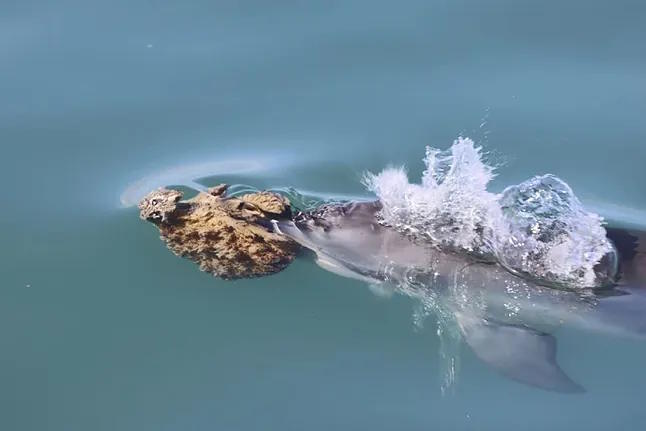Dolphins are considered one of the most intelligent animals on the planet and they continue to prove it. Some individuals of this species have developed a special technique in Australia to extract fish from the seabed using sea sponges that they handle with their snouts, reports AP.
Using the sponge to protect themselves from sharp rocks, the dolphins swim with the tip of their snout covered and stir the bottom of sandy channels to detect the presence of some fish to feed on. However, this behavior—passed down through generations—is more complicated than it seems, according to a new study published on Tuesday in the journal Royal Society Open Science.
Hunting while carrying a sponge on the face interferes with the sharp echolocation sense of bottlenose dolphins, which involves emitting sounds and clicks and listening to their echo to navigate.
"It has a muffling effect in the same way a mask would," noted Ellen Rose Jacobs, co-author of the study and marine biologist at Aarhus University in Denmark. "Everything looks a bit odd, but you can still learn to compensate."
Jacobs used an underwater microphone to confirm that the dolphins in Shark Bay, Australia, continued to use echolocation clicks to navigate. She then modeled the extent of the distortion of sound waves caused by the sponges.
For those wild dolphins that have mastered sponge-feeding, scientists say it is a very efficient way to catch fish.
Sponge hunting "is like hunting with blindfolds on—you have to be very good, very well trained to do it well," stated Mauricio Cantor, marine biologist at Oregon State University, who was not involved in the study.
This difficulty may explain why it is so unusual, with only about 5% of the dolphin population studied in Shark Bay engaging in this practice. That's approximately 30 dolphins in total, Jacobs said.
"It takes many years for them to learn this special hunting skill; not all continue to use it," commented Boris Worm, marine ecologist at Dalhousie University in Canada, who was not part of the study.
Dolphin calves typically spend around three to four years with their mothers, observing and learning vital skills.
The delicate art of sponge hunting "is only passed from mother to calf," noted Janet Mann, co-author and marine biologist at Georgetown.
